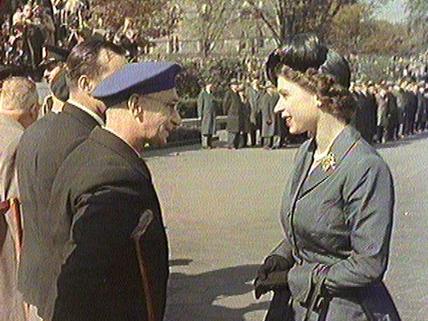Royal Journey
|
Canada, 1951 (documentaire, 54 minutes, couleurs, anglais)
|
|
Autre titre :
« Voyage royal »
|

|
| Image : © Office national du film du Canada |
Description du film :
« Récit de la visite d'Élisabeth II, alors qu'elle était princesse héritière, et du duc d'Édimbourg au Canada et aux États-Unis. Le couple princier est accueilli par les dignitaires et le peuple des deux pays dans des décors variés de villes, de villages, de grands espaces et de gigantesques accidents géographiques. Ce documentaire donne un aperçu des principales réceptions officielles dans les grandes villes, de l'accueil spontané des foules, des divertissements prévus en l'honneur de leurs Altesses. »
-- Office national du film du Canada
(source)
|
| Générique (partiel) : |
| Scénario : | Leslie McFarlane |
| Produit par : |
Tom Daley |
| Narrateur : |
Elwood Glover |
| Montage images : |
Ronald Dick, Victor Jobin, Betty Brunke |
| Musique : |
Louis Applebaum |
| Société de production : |
National Film Board of Canada / Office national du film du Canada |
(sources)
Prix décerné à Royal Journey
- Palmarès du film canadien : Theatrical Feature Length (Documentary) [long métrage sorti en salle (documentaire)] -- décerné à David Bairstow
Citations sur Royal Journey [en anglais]
« Everyone involved knew that shooting [Royal Journey in colour would greatly enhance its value and guarantee greater exposure in Canada and throughout the world. The problem was, apart from the costly Technicolor process, there were only a few inferior colour systems available. Technicolor was ruled out as it required the use of very bulky cameras as well as specially trained film crews. The NFB would not be able to use its own cameramen. The biggest problem however, was that Technicolor required bright sunshine or very powerful lighting to have any chance of looking good. The weather in Canada in the fall is very unpredictable and it is rare to have bright sunshine for long stretches and setting up bright lights during the tour was a logistic impossibility. NFB cameramen had heard of an experimental 35 mm film stock that Kodak was developing (Eastman colour) which was supposed to give true colours even during overcast or rainy days. The NFB contacted Kodak and filmed a couple of tests which everyone thought quite satisfactory »
-- Albert Ohayon
(source)
« Royal Journey, the NFB's record of Princess Elizabeth's Canadian tour in the fall of 1951, will always be remembered for being the first feature film ever shot on Eastman colour 35mm film stock. It was originally to be a 20-minute newsreel but the NFB had shot a lot of good material and was not sure what to do with it. The president of Famous Players cinemas, J.J. Fitzgibbons, was asked to look at the 60-minute rough cut of the film and advise the editors. He told them to cut nothing out, and that he would gladly show the film in his theatres on one condition: that it be ready for a Christmas release, just one month away. NFB employees worked day and night to complete the film on time. Columbia Pictures premiered it on December 21, 1951, in Ottawa and then released it throughout Canada. After only 3 weeks it had grossed $250,000 in Canada alone. It was released in New York City by United Artists in January of 1952 and played throughout the USA. Royal Journey was, at the time, the most widely seen feature film in Canada, ever—2 million Canadians saw it in the first 3 years of release. »
-- Albert Ohayon
(source)
Bibliographie sur Royal Journey
Articles de journaux, de revues grand public ou de sites d'information en ligne
-
OHAYON, Albert. « Royal Journey: The National Film Board's first major hit », NFB Blog, 4 octobre 2010.
[en anglais]
Sites Web sur Royal Journey


